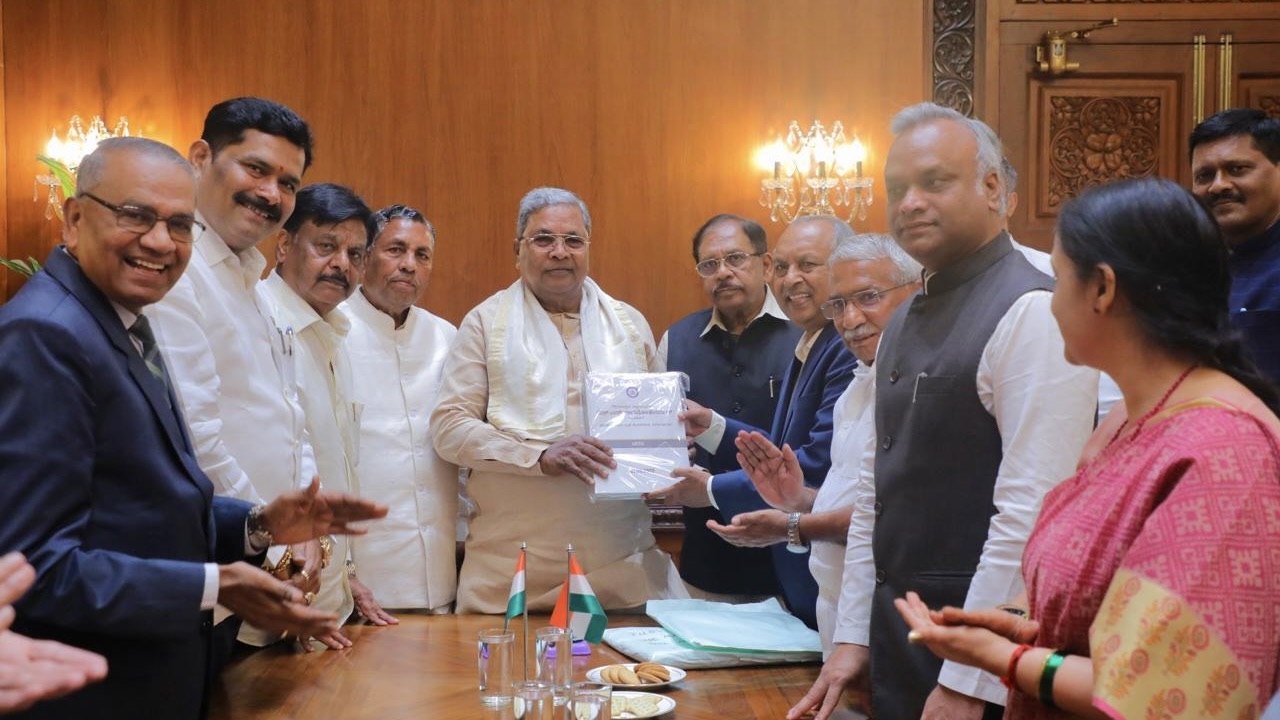The Commission is understood to have proposed a formula to distribute the existing 17 percent SC reservation among SC (Right), SC (Left), “touchable” communities, and nomadic groups.
Published Aug 04, 2025 | 5:53 PM ⚊ Updated Aug 04, 2025 | 5:55 PM

Chief Minister Siddaramaiah receives the report.
Synopsis: The Justice Nagamohan Das Commission on Monday submitted to the Karnataka Government a 1,766-page report on internal reservation among the Scheduled Castes, based on a caste-wise survey conducted in May and July 2025. The survey covered 27,24,768 families and 1,07,01,982 individuals, with classification and recommendations prepared in line with Supreme Court–mandated criteria. The report will be placed before the Cabinet on 7 August.
The Justice HN Nagamohan Das Commission has submitted its detailed report on internal reservation among the Scheduled Castes (SCs) in Karnataka. The report follows a comprehensive caste-wise survey conducted across the state between 5 May and 6 July 2025.
A total of 27,24,768 SC families and 1,07,01,982 individuals took part in the survey. The classification and recommendations are based on Supreme Court–mandated criteria, including educational and social backwardness, and underrepresentation in government services.
“The report on internal reservation among the Scheduled Castes has been submitted today by Justice Nagamohan Das. This will be placed before the Cabinet at its meeting on 7 August,” Chief Minister Siddaramaiah told reporters on Monday, 4 August.
ಪರಿಶಿಷ್ಟ ಜಾತಿಗಳ ಒಳಮೀಸಲಾತಿ ಜಾರಿ ಸಂಬಂಧ ಅಧ್ಯಯನಕ್ಕಾಗಿ ರಚಿಸಲಾಗಿದ್ದ ನಿವೃತ್ತ ನ್ಯಾಯಮೂರ್ತಿ ಹೆಚ್.ಎನ್. ನಾಗಮೋಹನ್ ದಾಸ್ ಅವರ ಸಮಿತಿಯವರು ಇಂದು ತಮ್ಮ ಅಧ್ಯಯನ ವರದಿ ಸಲ್ಲಿಸಿದರು.
ವರದಿ, ಸಮೀಕ್ಷೆಯ ದತ್ತಾಂಶ ಹಾಗೂ ಅನುಬಂಧಗಳು ಒಟ್ಟು ಸೇರಿ ಸುಮಾರು 1766 ಪುಟಗಳು ಮತ್ತು 6 ಶಿಫಾರಸುಗಳನ್ನು ಒಳಗೊಂಡ ವರದಿ ಇಂದು ಸಲ್ಲಿಕೆಯಾಗಿದ್ದು,… pic.twitter.com/WY4FeL589P
— Siddaramaiah (@siddaramaiah) August 4, 2025
Home Minister Dr G Parameshwara said: “In a matter of two months, this report has been submitted to the government. We do not know the contents of the report. Once it is accepted, the CM will place it before the Cabinet, and only then will we know the recommendations.”
When contacted by South First, Justice Nagamohan Das said: “I have submitted the report. I have done my job.”
The final report runs to 1,766 pages, including data and appendices, and contains six major recommendations. Notably, Justice Das did not accept any remuneration for his work.
The Commission is understood to have proposed a formula to distribute the existing 17 percent SC reservation among SC (Right), SC (Left), “touchable” communities, and nomadic groups.
The recommendations aim to address long-standing socio-economic disparities within SC sub-groups and ensure equitable access to education and government jobs.
The report comes at a crucial time, with recruitments and promotions under the SC quota stalled pending clarity on internal reservation.
In its 2023 election manifesto, the ruling Congress had promised internal reservation for SC communities. On the ground, the demand for detailed data has grown amid concerns over inconsistencies in the classification of sub-castes.
On 1 August 2024, the Supreme Court, in Punjab and Others vs Devendra Singh and Others, held that internal reservation is permissible under the Constitution. The order stated that the 17 percent reservation quota would be divided among 101 Scheduled Castes in the state.
The three-phase survey, led by Justice Das, a retired High Court judge, involved door-to-door data collection, special camps, and online self-declaration. The state allocated ₹100 crore for the project.
Karnataka currently provides 17 percent reservation for Scheduled Castes, covering 101 sub-castes.
The move to refine reservation within SC groups dates back to 2005, when the state set up the Justice AJ Sadashiva Committee. The committee submitted its report in 2012, but it was never implemented due to objections from both left and right subgroups over population estimates.
Until 2022, SCs in Karnataka were entitled to 15 percent reservation. That year, the government led by then Chief Minister Basavaraj Bommai increased it to 17 percent.
(Edited by Dese Gowda)
